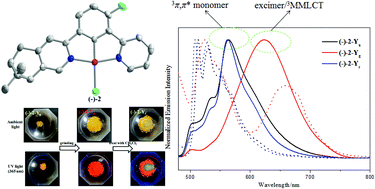Mechanochromic luminescence properties of fluoro-substituted pinene-containing cyclometalated platinum(ii) complexes with multiple triplet excited states†
Abstract
The structure–mechanochromism relationship is explored with respect to packing patterns and corresponding intermolecular interactions that are affected by the number and location of –F. The distinct and reversible mechanochormic luminescence (Δλem up to ca. 90 nm) of yellow solids (−)-1-Yg, (−)-2-Yg, and (−)-3-Yg was displayed with a simultaneous crystal-to-amorphous transformation. The change of multiple triplet excited states accounted for the mechanochormic luminescence, and a switch from the 3π,π* monomer to the excimer/3MMLCT occurred in the grinding process. The mechanical force led to perturbation in the molecular packing, and aggregates with effective Pt⋯Pt and π–π interactions were formed in the amorphous phase, leading to the variation of excited states. The mechanochromic luminescence could be reverted by dropping in CH2Cl2 and could be cycled multiple times without perceivable performance degradation. This work gives a reference for designing mechanochromic luminescent materials toward multicolor and multicomponent responses.



 Please wait while we load your content...
Please wait while we load your content...